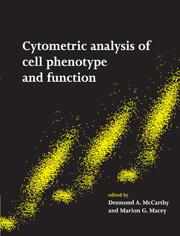Book contents
- Frontmatter
- Contents
- List of contributors
- List of abbreviations
- 1 Principles of flow cytometry
- 2 Introduction to the general principles of sample preparation
- 3 Fluorescence and fluorochromes
- 4 Quality control in flow cytometry
- 5 Data analysis in flow cytometry
- 6 Laser scanning cytometry: application to the immunophenotyping of hematological malignancies
- 7 Leukocyte immunobiology
- 8 Immunophenotypic analysis of leukocytes in disease
- 9 Analysis and isolation of minor cell populations
- 10 Cell cycle, DNA and DNA ploidy analysis
- 11 Cell viability, necrosis and apoptosis
- 12 Phagocyte biology and function
- 13 Intracellular measures of signalling pathways
- 14 Cell–cell interactions
- 15 Nucleic acids
- 16 Microbial infections
- 17 Leucocyte cell surface antigens
- 18 Recent and future developments: conclusions
- Appendix
- Index
- Plate section
15 - Nucleic acids
Published online by Cambridge University Press: 06 January 2010
- Frontmatter
- Contents
- List of contributors
- List of abbreviations
- 1 Principles of flow cytometry
- 2 Introduction to the general principles of sample preparation
- 3 Fluorescence and fluorochromes
- 4 Quality control in flow cytometry
- 5 Data analysis in flow cytometry
- 6 Laser scanning cytometry: application to the immunophenotyping of hematological malignancies
- 7 Leukocyte immunobiology
- 8 Immunophenotypic analysis of leukocytes in disease
- 9 Analysis and isolation of minor cell populations
- 10 Cell cycle, DNA and DNA ploidy analysis
- 11 Cell viability, necrosis and apoptosis
- 12 Phagocyte biology and function
- 13 Intracellular measures of signalling pathways
- 14 Cell–cell interactions
- 15 Nucleic acids
- 16 Microbial infections
- 17 Leucocyte cell surface antigens
- 18 Recent and future developments: conclusions
- Appendix
- Index
- Plate section
Summary
Introduction
Although much remains to be elucidated, the molecular mechanisms underlying or associated with a number of human diseases have, in the 1990s, become better understood. With the completion of the Human Genome Project, we can expect human disease-associated loci or genes to be discovered with greater frequency. The accompanying paradigm shift in laboratory medicine to a wider use of molecular techniques in the diagnosis of human disease is clearly reflected in the new proposed World Health Organization classification of acute leukaemias. At the same time there is a move to use of molecular detection methods for the determination of antibiotic resistance genes in bacterial infections. Clinicians will increasingly be expected to understand the genetic basis of disease and to interpret the results of laboratory tests aimed at detecting or reflecting events at the genetic level.
Where there is a strong correlation and specificity between an underlying genetic alteration and cellular immunophenotype, cytometry may be a costeffective and powerful screening tool. However, combined genetic and immunophenotypic analysis at the single cell level can provide information that is essential to a better understanding of the role of cellular heterogeneity in disease onset and progression and of the response to therapy. This can be facilitated by linking sequence-specific nucleic acid detection techniques with classical cell-based quantitative, multiparameter approaches such as flow cytometry or laser scanning cytometry. Thus subpopulations that are positive for a specific genetic sequence, genetic alteration or infectious organism can be detected within cell populations of a given immunophenotype; conversely, immunophenotypic heterogeneity can be determined within cell populations containing a particular nucleic acid sequence.
Information
- Type
- Chapter
- Information
- Cytometric Analysis of Cell Phenotype and Function , pp. 271 - 291Publisher: Cambridge University PressPrint publication year: 2001
Accessibility standard: Unknown
Why this information is here
This section outlines the accessibility features of this content - including support for screen readers, full keyboard navigation and high-contrast display options. This may not be relevant for you.Accessibility Information
- 2
- Cited by
